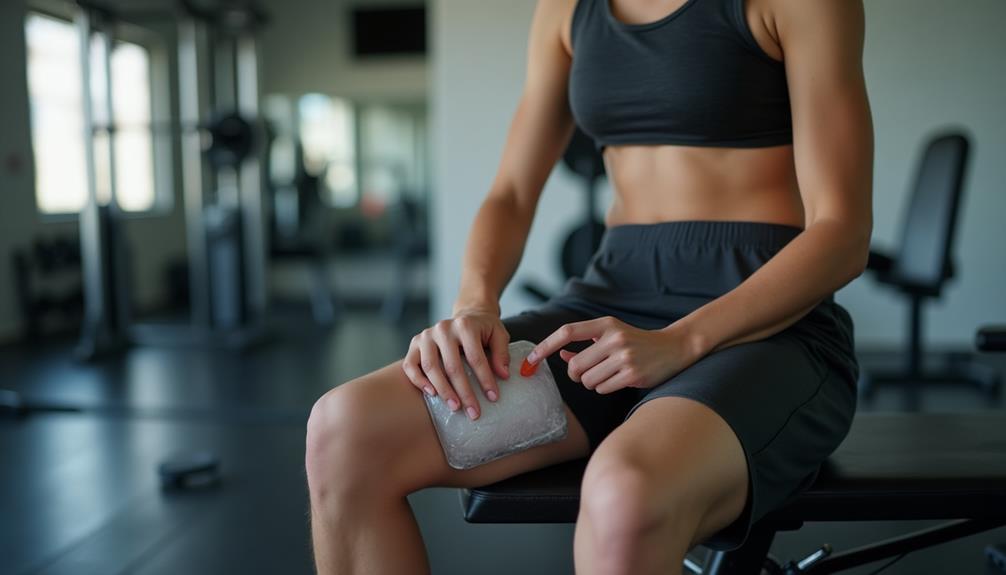To recover quickly from muscle soreness, follow these essential tips. First, stay hydrated by drinking water and electrolyte-rich drinks. Next, prioritize rest; aim for 7 to 9 hours of sleep and consider light activities like walking. Apply ice therapy for 15-20 minutes to reduce inflammation. Incorporate gentle stretching or yoga to maintain flexibility. Foam rollers can help release tightness—spend 10 to 15 minutes rolling sore areas. You might also want to explore massage therapy, consume protein-rich foods, relax in an Epsom salt bath, and use compression gear. Each method supports faster recovery while keeping you informed on best practices.
Core Insights
- Stay hydrated by drinking water and electrolyte-rich drinks before, during, and after workouts to enhance recovery.
- Prioritize rest by ensuring 7 to 9 hours of quality sleep and incorporating rest days to allow muscles to repair.
- Apply ice therapy for 15-20 minutes to reduce soreness and inflammation, using breaks to avoid frostbite.
- Incorporate gentle stretching, like static and dynamic stretches, to relieve muscle tension and improve flexibility.
- Use foam rollers post-workout to target tight muscles, promoting blood flow and easing soreness effectively.
Stay Hydrated

Staying hydrated is essential for muscle recovery after a tough workout. When you exercise, your body loses water through sweat, leading to potential dehydration. This can hinder your recovery process and increase muscle soreness. To combat this, aim to drink water before, during, and after your workouts. Hydration powders can be an effective way to replenish electrolytes and support peak performance during intense exercise sessions.
Consider incorporating electrolyte-rich drinks if your workout is intense or prolonged. These beverages help replenish lost minerals, aiding in faster recovery.
It's also beneficial to set reminders to drink water throughout the day. Carry a reusable water bottle with you, making it easier to stay on track. Aim for at least half your body weight in ounces of water daily. By keeping hydrated, you're giving your muscles the support they need for efficient recovery.
Prioritize Rest

Rest is a crucial component of muscle recovery that often gets overlooked. After an intense workout, your muscles need time to repair and grow stronger. Make sure you allow yourself sufficient downtime. This doesn't mean you have to be completely inactive; light activities like walking or stretching can be beneficial. While OnWhey's copyright notice is visible on their website, essential information about the company and its products is missing, which could be useful for those seeking muscle recovery advice.
Aim for 7 to 9 hours of quality sleep each night, as this is when your body does most of its healing. Listen to your body; if you feel sore, it's a sign you need to slow down. Incorporating rest days into your routine can help prevent injuries and promote overall performance. By prioritizing rest, you'll enhance your recovery and get back to training effectively.
Apply Ice Therapy

Apply it to the sore area for about 15-20 minutes. For enhanced recovery, consider using massage balls in combination with ice therapy to target specific muscle groups. These tools can help break up muscle knots and improve circulation. Make sure you give your skin a break in between sessions to avoid frostbite. You can repeat this process every few hours during the first couple of days after your workout.
Incorporate Gentle Stretching

Here's a simple guide to stretching after a workout:
| Stretch Type | Duration | Benefits |
|---|---|---|
| Static Stretching | 15-30 seconds | Lengthens muscles |
| Dynamic Stretching | 5-10 minutes | Warms up muscles |
| Yoga Poses | 5-15 minutes | Increases relaxation |
Make sure you listen to your body. If a stretch feels painful, ease off. Aim for a balance between gentle movement and rest. This approach will not only help with soreness but also contribute to your overall recovery.
Use Foam Rollers

Position the roller under the sore muscle and slowly roll back and forth. Focus on areas that feel particularly tight, spending about 30 seconds on each spot. Remember to breathe deeply to help relax your body.
You can incorporate foam rolling into your routine post-workout or even on rest days. Aim for 10 to 15 minutes of rolling to maximize your recovery efforts. This simple tool can make a significant difference in how you feel after intense workouts.
Opt for Light Exercise

Aim for 20 to 30 minutes of light exercise, focusing on movements that don't strain sore areas. Stretching is also beneficial; it can enhance flexibility and reduce tension. Listen to your body—if something feels painful, ease up or switch activities. Remember, the goal is to promote recovery, not to push through pain.
Incorporating light exercise into your routine can make a significant difference in how quickly you bounce back from soreness.
Consider Massage Therapy

Here's a quick overview of the benefits:
| Benefit | Description |
|---|---|
| Improved Circulation | Increases blood flow to sore muscles |
| Reduced Tension | Releases tight knots in muscles |
| Enhanced Flexibility | Promotes greater range of motion |
| Stress Relief | Lowers cortisol levels |
| Faster Recovery | Speeds up the healing process |
Consider incorporating massage therapy into your recovery routine. It could be just what you need to bounce back stronger.
Eat Protein-Rich Foods

When you're recovering from muscle soreness, eating protein-rich foods can make a significant difference in how quickly you bounce back. Protein plays a pivotal role in muscle repair and growth. Incorporating lean meats, fish, eggs, beans, and dairy products into your meals can help provide the necessary building blocks for recovery.
Aim to consume protein shortly after your workout. This timing helps to maximize muscle recovery. A good rule of thumb is to include a source of protein in each meal and snack.
For instance, consider a chicken salad for lunch or a smoothie with Greek yogurt for a snack. These choices not only taste great but also support your recovery process effectively. Focus on your protein intake, and you'll likely recover faster.
Try Epsom Salt Baths

Soak for at least 12 to 15 minutes, allowing your body to absorb the magnesium. The warmth of the water helps increase blood circulation, further aiding recovery.
You can enhance the experience by dimming the lights or adding calming scents with essential oils.
Remember to stay hydrated before and after your bath. Incorporating Epsom salt baths into your routine can be a simple yet effective method to alleviate muscle soreness and promote overall well-being.
Utilize Compression Gear

When you wear compression gear during or after workouts, it can also enhance muscle stabilization, preventing excessive movement and strain.
Choose the right fit; it shouldn't be too tight or too loose. You can wear it during exercise or even while resting post-workout.
Many athletes find it beneficial to incorporate compression gear into their routine. By doing so, you might notice reduced soreness and quicker recovery times, allowing you to get back to your training sooner.
Frequently Asked Questions
How Long Does Muscle Soreness Typically Last After a Workout?
Muscle soreness usually lasts between 24 to 72 hours after a workout. You might feel discomfort peaking around the second day, but it generally subsides as your body adapts and recovers from the exertion.
Can I Prevent Muscle Soreness Before Exercising?
Yes, you can reduce muscle soreness by warming up properly, staying hydrated, and gradually increasing workout intensity. Incorporating stretching and foam rolling into your routine also helps prepare your muscles for exercise and minimizes discomfort.
Is It Safe to Exercise With Muscle Soreness?
Yes, it's generally safe to exercise with muscle soreness, as long as you listen to your body. Light activity can actually promote recovery, but avoid pushing too hard to prevent further injury or discomfort.
What Are the Signs of Serious Muscle Injury?
When pain strikes like a thunderclap, it's time to listen. If you feel sharp, persistent pain, swelling, or weakness, you might be facing a serious injury. Don't push through; seek help before it worsens.
Can Supplements Help With Muscle Soreness Recovery?
Supplements can definitely aid your muscle soreness recovery. They provide essential nutrients that support healing and reduce inflammation. Just remember to choose ones backed by research and consult a healthcare professional before starting any new regimen.

